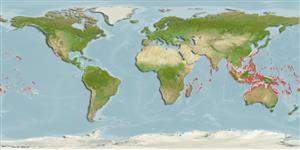>
Ovalentaria/misc (Various families in series Ovalentaria) >
Pomacentridae (Damselfishes) > Microspathodontinae
Etymology: Plectroglyphidodon: Greek,plektron = anything to strike with, spur + Greek, glyphis = carved + Greek, odous = teeth (Ref. 45335).
Eponymy: The Honorable George F Dick was Colonial Secretary of Mauritius and the President of the Natural History Society of Mauritius (1836–1850). He retired to his native Ireland. (Ref. 128868), visit book page.
Environment: milieu / climate zone / depth range / distribution range
Ecologia
marino associati a barriera corallina; non migratori; distribuzione batimetrica 0 - 20 m (Ref. 128797). Tropical; 30°N - 30°S
Indo-Pacific: East Africa to the Line and Tuamoto islands, north to Japan, south to Australia.
Size / Peso / Age
Maturity: Lm ? range ? - ? cm
Max length : 11.6 cm TL maschio/sesso non determinato; (Ref. 124696); peso massimo pubblicato: 35.62 g (Ref. 124696)
Short description
Chiavi di identificazione | Morfologia | Morfometria
Spine dorsali (totale) : 12; Raggi dorsali molli (totale) : 16 - 18; Spine anali: 2; Raggi anali molli: 14 - 16.
Adults inhabit coral-rich and surge areas of clear lagoon and seaward reefs (Ref. 1602). Commonly associated with Pocillopora or Acropora corals (Ref. 1602). Feed on filamentous algae, small benthic invertebrates, and occasionally small fishes (Ref. 1602). Oviparous, distinct pairing during breeding (Ref. 205). Eggs are demersal and adhere to the substrate (Ref. 205). Males guard and aerate the eggs (Ref. 205). Diurnal species (Ref. 54980; 113699).
Life cycle and mating behavior
Maturità | Riproduzione | Deposizione | Uova | Fecundity | Larve
Oviparous, distinct pairing during breeding (Ref. 205). Eggs are demersal and adhere to the substrate (Ref. 205). Males guard and aerate the eggs (Ref. 205).
Allen, G.R., 1991. Damselfishes of the world. Mergus Publishers, Melle, Germany. 271 p. (Ref. 7247)
IUCN Red List Status (Ref. 130435: Version 2024-1)
Threat to humans
Harmless
Human uses
Pesca: scarso interesse commerciale; Acquario: Commerciale
Strumenti
Special reports
Download XML
Fonti Internet
Estimates based on models
Preferred temperature (Ref.
123201): 25 - 29.3, mean 28.3 °C (based on 2789 cells).
Phylogenetic diversity index (Ref.
82804): PD
50 = 0.5010 [Uniqueness, from 0.5 = low to 2.0 = high].
Bayesian length-weight: a=0.02042 (0.01167 - 0.03573), b=2.98 (2.82 - 3.14), in cm total length, based on LWR estimates for this species & (Sub)family-body (Ref.
93245).
Trophic level (Ref.
69278): 3.7 ±0.3 se; based on diet studies.
Resilienza (Ref.
120179): Alto, tempo minimo di raddoppiamento della popolazione meno di 15 mesi (Preliminary K or Fecundity.).
Fishing Vulnerability (Ref.
59153): Low vulnerability (10 of 100).
Nutrients (Ref.
124155): Calcium = 99.9 [49.4, 166.6] mg/100g; Iron = 0.679 [0.390, 1.141] mg/100g; Protein = 18.6 [17.4, 19.7] %; Omega3 = 0.119 [0.069, 0.199] g/100g; Selenium = 19.1 [10.3, 38.1] μg/100g; VitaminA = 119 [35, 402] μg/100g; Zinc = 1.48 [0.97, 2.16] mg/100g (wet weight);
